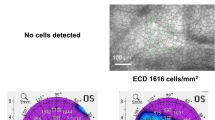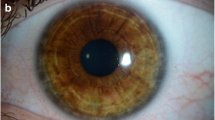Abstract
• Background: The presence, morphology and distribution of ED1 and ED2+ cells have been recently reported in detail in the uveal tissues of the rat. These cells, particularly those of dendritic morphology, are possibly capable of antigen presentation and, therefore, may play an important role in immune processes of uveal and other ocular tissues. Using the whole-mount technique, the distribution of ED1+ and ED2+ cells in the rat iris and choroid was investigated following penetrating keratoplasty (PKP) and following treatment with cyclosporin A (CsA). • Methods: Lewis (LW) rats received corneal buttons from Lewis-Brown Norway (LW-BN) donors and were randomly assigned to one of two groups: (I) operated, untreated (n=24); (II) operated, CsA treated (10 mg/kg i.m.;n=22). Four groups served as controls: normal LW rats (n=13); (IV) unoperated, CsA treated (16 days' treatment;n=8); (V) eight corneal sutures only, representing a simulated or “sham” operation (n=4); (VI) syngeneic operated (LW to LW;n=4). Animals of groups I and II were killed on the 5th, 9th and 13th postoperative days and on appearance of the corneal rejection (group 1, day 13; Group II, day 16). Both eyes were enucleated, immediately fixed, and iris-choroid flat mounts were examined for ED 1 + and ED2+ cells using APAAP immunohistochemistry. • Results: In the normal LW rat iris, ED 1 + and ED2+ cells of both non-dendritic and dendritic morphology were observed. The placement of sutures in the cornea and PKP with or without treatment resulted in a reasonably regular response in both the iris and the choroid in the operated and partner eye. These included: (a) an increase in round iridal ED l+ and ED2+ cells in the operated eye and in round ED 1+ cells in the partner eye; (b) a decrease in dendritiform ED2+ cells in the iris of the operated eyes as well as in the partner eye; and (c) a decrease in the dendritiform ED2+ cells in the choroid of the operated and partner eye. CsA treatment alone in unoperated animals resulted in significant decreases in the number of dendriti-form ED1+ cells in the iris and in the dendritiform ED2+ cells in the choroid. • Conclusion: Corneal transplantation in the Lewis rat results in responses in ED1+ and ED2+ cells in uveal tissues in both the operated eye as well as in the partner eye. The differences in cell behaviour supports the idea that distinct immune-competent cell populations are present within uveal tissues and that they may have differing roles in the pathological eye.
Similar content being viewed by others
References
Brenan M, Puklavec M (1992) The MRC OX62 antigen: a useful marker of rat veiled cells with the biochemical properties of an integrin. J Exp Med 175:1457–1465
Cordell J, Falini B, Erber WN, Ghosh AK, Abulaziz Z, MacDonald S, Pulford KA, Stein H, Mason DY (1984) Immunoenzymatic labeling of monoclonal antibodies using immune complexes of alkaline phosphatase and monoclonal anti-alkaline phosphatase (APAAP complexes). J Histochem Cytochem 32:219–229
Coupland SE, Penfold PL, Billson FA, Hoffmann F (1994) Hydrolase participation in allograft rejection in rat penetrating keratoplasty. Graefe's Arch Clin Exp Ophthalmol 232:614–621
Coupland SE, Klebe S, Karow AC, Krause L, Bartlett RR, Hoffmann F (1994) Leflunomide following penetrating keratoplasty in the rat. Graefe's Arch Clin Exp Ophthalmol 232:622–627
Coupland SE, Krause L, Hoffmann F (1996) The influence of penetrating keratoplasty and cyclosporin A therapy on MHC class-II (Ia) positive cells in the rat iris and choroid. Graefe's Arch Clin Exp Ophthalmol 234:116–124
Daar AS, Fuggle SV, Fabre JW, Ting A, Morris PJ (1984) The detailed description of MHC Class II antigens in normal human organs. Transplantation 38:293–298
Damoiseaux JGMC, Döpp EA, Calame W, Chao D, MacPherson GG (1994) Rat macrophage lysosomal membrane antigen recognised by monoclonal antibody ED1. Immunology 83:140–147
Dijkstra CD, Döpp EA, Joling P, Kraal G (1985) The heterogeneity of mononuclear phagocytes in lymphoid organs: distinct macrophage subpopulations in the rat recognised by monoclonal antibodies ED1, ED2 and ED3. Immunology 54:589–599
Forrester JV, McMenamin PG, Holthouse I, Lumsden L, Liversidge J (1994) Localization and characterization of major histocompatibility complex Class II-positive cells in the posterior segment of the eye implications for induction of autoimmune uveoretinitis. IOVS 35:64–77
Groenewegen G, Buurman WA, Jeunhomme GMAA, van der Linden GJ (1985) Effect of cyclosporin on MHC class Il antigen expression on arterial and venous endothelium of mouse skin allografts. Transplantation 40:21–25
Halloran PE, Wadeymar A, Autenried P (1986) Inhibition of MHC product induction may contribute to the immunosuppressive action of ciclosporin. Prog Allergy 38:258
Hess AD, Esa AH, Colombani PM (1988) Mechanisms of action of cyclosporine: effect on cells of the immune system and on subcellular events in T cell activation. Transplant Proc 20 [Suppl 2]:29–40
Holland EJ, Chan CC, Wetzig RP, Palestine AG, Nussenblatt RB (1991) Clinical and immunohistologic studies of corneal rejection in the rat penetrating keratoplasty model. Cornea 10:374–380
Knisely TL, Anderson TM, Sherwood ME, Flotte TJ, Albert DM, Granstein RD (1991) Morphologic and ultrastructural examination of I-A+ cells in the murine iris. Invest Ophthalmol Vis Sci 2423–2431
Liversidge J, Thomson AW, Sewell HF, Forrester JV (1987) EAU in the guinea pig: inhibition of cell-mediated immunity and la antigen expression by cyclosporin A. Clin Exp Immunol 69:591–600
Liversidge J, Sewell HF, Thomson AW, Forrester JV (1988) Lymphokineinduced MHC class II antigen expression on cultured retinal pigment epithelial cells and the influence of cyclosporin A. Immunology 63:313–317
McMenamin PG, Holthouse I (1992) Immunohistochemical characterisation of dendritic cells and macrophages in the aqueous outflow pathways of the rat eye. Exp Eye Res 55:315–324
McMenamin PG, Holthouse I, Holt PG (1992) Class II histocompatibility complex (la) antigen-bearing dendritic cells within the iris and ciliary body of the rat eye: distribution, phenotype and relation to retinal microglia. Immunology 77:385–393
McMenamin PG, Crewe J, Morrison S, Holt PG (1994) Immunomorphologic studies of macrophages and MHC Class II-positive cells in the iris and ciliary body of the rat, mouse and human eye. Invest Ophthalmol Vis Sci 35:3234–3250
Steinman RM (1991) The dendritic cell system and its role in immunogenicity. Annu Rev Immunol 9:271–296
Unaue ER, Allen PM (1987) The basis for the immunoregulatory role of macrophages and other accessory cells. Science 236:551–557
Van Furth R, Cohn Z, Hirsch JG, Spector WG, Langevoot HL (1972) The mononuclear phagocyte system: a new classification of macrophages, monocytes and their precursor cells. Bull World Health Org 46:845
Waal EJ de, Rademakers LHPM, Schuurman HJ, Loveren H van (1993) Ultrastructure of interdigitating cells in the rat thymus during cyclosporin A treatment: In: Kamperdijk EWA, Nieuwenhuis P, Hoefsmit ECM (eds) Dendritic cells in fundamental and clinical immunology. Plenum Press, New York, pp 153–157
Westermann J, Ronnenberg S, Fritz FJ, Pabst R (1989) Proliferation of macrophage subpopulations in the adult rat: comparison of various lymphoid organs. J Leukoc Biol 46:263–269
Williams KA, Coster DJ (1985) Penetrating corneal transplantation in the inbred rat: a new model. Invest Ophthalmol Vis Sci 26:23–30
Williams KA, Standfield SD, Wing SJ, Barras CW, Mills RA, Comacchio RM, Coster DJ (1992) Patterns of corneal graft rejection in the rabbit and reversal of rejection with monoclonal antibodies. Transplantation 54:38–43
Zierhut M, Pleyer U (1994) Immunology of corneal graft rejection. In: Zierhut M, Pleyer U, Thiel HJ (eds) Immunology of corneal transplantation. Butterworth/Heinemann, Boston, pp 145–161
Author information
Authors and Affiliations
Rights and permissions
About this article
Cite this article
Krause, L., Coupland, S.E. & Hoffmann, F. The behaviour of ED1- and ED2-positive cells in the rat iris and choroid following penetrating keratoplasty and cyclosporin A therapy. Graefe's Arch Clin Exp Ophthalmol 234 (Suppl 1), S149–S158 (1996). https://doi.org/10.1007/BF02343065
Received:
Revised:
Accepted:
Issue Date:
DOI: https://doi.org/10.1007/BF02343065




